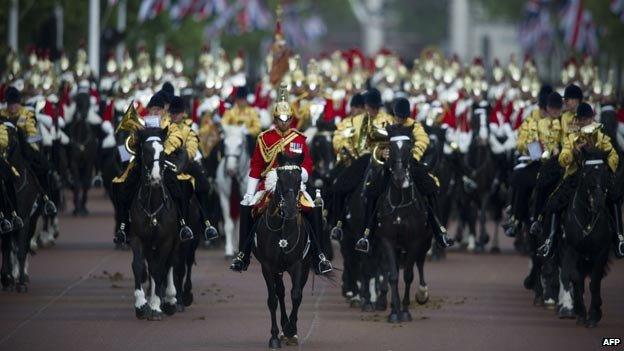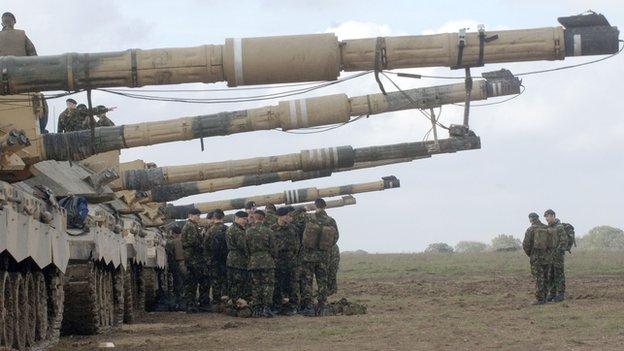Why does the British Army have more horses than tanks?
- Published

The Household Cavalry at the Trooping of the Colour
Why does the Ministry of Defence have more horses than it does tanks?
Britain's armed forces are undergoing huge changes.
Redundancies have been confirmed ahead of the release next week of a UK government spending review which is expected to announce a 1% increase in military equipment budgets, but also 5% reduction in spending overall.
Chief Secretary to the Treasury Danny Alexander has praised the MoD's plans to shave millions of pounds off its procurement budget.
In an interview with Sky News, the Lib Dem MP for Inverness, Nairn, Badenoch and Strathspey said: "In a department where there are more horses than tanks, there is room for efficiency savings."
The MoD's official figures show the British Army does indeed have more horsepower of the four leg variety, than the heavy metal.
An MoD spokesman said that as of July 2012 - the most up-to-date figures available - there were 501 horses and 334 tanks, which includes the Challenger 2 main battle tank.
The spokesman added that the department was making no comment on what Mr Alexander had said to Sky.
The British Army has not used horses in a combat role since World War I, when a million were sent to the frontline and only about 62,000 survived.
During World War II, Gen Orde Wingate and his British Chindit raiders used horses and mules to carry supplies behind enemy lines in Burma.
The animals had their voice boxes removed to prevent them from braying and alerting Japanese patrols.
Today, horses fulfil a purely ceremonial role going back hundreds of years.
Two mounted elements survive in the modern British Army.
The Household Cavalry was formed in 1661 on the orders of King Charles II and now consists of the Life Guards and the Blues and Royals, the oldest regiments in the Army.
The other is the King's Troop Royal Horse Artillery. Its troopers drive teams of six horses pulling World War I saluting guns.
Both the cavalry and horse artillery were on show on Saturday when 200 horses were a feature of the Trooping of the Colour.
The occasion marked the Queen's official birthday but also continued a military tradition going back to the early 1700s.
Horses and troopers, the men and women who take charge of the animals, are also trotted out for other Royal events, such as weddings and jubilees, as well as for Remembrance Sunday at London's Cenotaph, the Lord Mayor's Show and state occasions.
Behind the pomp and ceremony, the troopers are tasked with protecting the Queen and her family. They also regularly serve overseas on operations and have frequently been deployed to Iraq and Afghanistan, riding out on patrols in tracked Warrior armoured-personnel carriers.
But according to the British Army's An Introduction to the Household Cavalry Mounted Regiment, the ceremonial duties also send out a message to the rest of the world about the Army's operational capabilities.
The document says: "For a country with global interests these roles offer a powerful symbol of our operational military heritage, whilst enhancing the standing of the Sovereign and the Nation before both national and international audiences."

The Challenger 2 is the British Army's main battle tank
Meanwhile, the tank has been a key feature of the British Army ever since World War I.
Challenger battle tanks were sent to former Yugoslavia during the Balkans War in the 1990s and were used in the US-UK invasion of Iraq in March 2003.
But under its Future Force 2020 programme to reshape the armed forces, the government has proposed that the Army significantly reduce its number of Challenger 2 tanks.
"All through the history of the tank it has always been thought to be at the end of its life," said David Willey, curator of The Tank Museum.
"The tank was invented to bring mobility back to the First World War battlefield and at the end of the war they were brought back here to Bovington and chopped up for scrap.
"The thinking was that we would not need tanks again because we were never going to have a war like that again.
"But in the late 1920s on Salisbury Plain what was to be a three-day exercise was held involving the traditional infantry on foot, horse-drawn artillery and cavalry against a mechanised force including tanks.
"By midday of day one the mechanised element had won the exercise."
Mr Willey said forward-thinking members of the top brass, many of them who had served on or seen the potential of tanks in World War I, pushed the British Army towards mechanisation.
Other countries such as the US had almost abandoned the use of tanks. Even in World War II, the armies of Germany and Russia continued to rely heavily on horses.
Mr Willey said the future of tanks was questioned at the end of that war and also the Cold War between the West and the Soviet Eastern Bloc.
Concerns have included advances in anti-tank technology which can allow a single combatant to damage, or destroy, a big, expensive tank with a relatively low-cost handheld weapon.
"You could say we are experiencing another wobble over the future of tanks now," said the curator.
But he said the British Army was not alone and other European countries have also been looking at the future of their tank fleets.
However, Mr Willey believed the machines will continue to be a relevant tool not only on the battlefield, but even in counter-insurgency operations.
He said: "In Iraq, the infantry loved it when they had this massive great lump behind them. British tanks were not deployed to Afghanistan, but British soldiers used Danish and Canadian tanks on operations.
"The Danish officer in charge was quoted saying that 'there were days we didn't have to fight because we turned up with our tanks'."
Douglas Young, a reservist who served in the headquarters of the UK's 1st Armoured Division throughout the first Gulf War, said horses versus tanks was an interesting debate.
The chairman of the British Armed Forces Federation said: "The figures don't necessarily mean we have got too many horses, it's more likely the figures mean we don't have enough tanks.
"There were quite a number of horses on parade at the Trooping of the Colour on Saturday. I was there and many people will have watched it on TV.
"If the country doesn't want ceremonial occasions such as the Trooping of the Colour it can say so,"
Mr Young said a more important question for people was whether or not they were prepared to pay for the Army, Royal Navy and RAF to be properly equipped and resourced.
He added: "Recent operations such as Iraq have been very controversial, but think back to what happened in the Balkans."
Mr Young said atrocities amid the collapse of Yugoslavia caused a public outcry and required military intervention by Britain and its Nato allies.
"Something like the Balkans could happen again," he said.
- Published18 June 2013
- Published15 June 2013
- Published14 June 2013
- Published2 March 2013